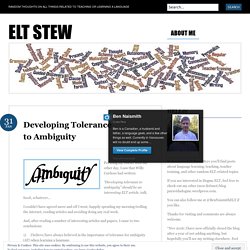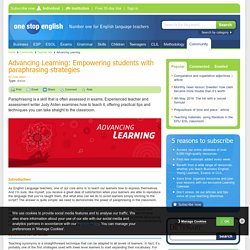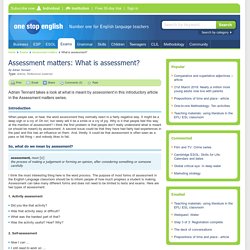Articles & Blog Posts
> Halito27
Developing Tolerance to Ambiguity. Perusing my twitter feed the other day, I saw that Willy Cardoso had written: “Developing tolerance to ambiguity” should be an interesting ELT article, talk, book, whatever… I couldn’t have agreed more and off I went, happily spending my morning trolling the internet, reading articles and avoiding doing any real work.

And, after reading a number of interesting articles and papers, I came to two conclusions:
Making reading communicative. And these reactions are from my adult students. My young learners' reactions may be even more extreme.
A critique of ELT teacher trainers. Advancing Learning: Empowering students with paraphrasing strategies. By Judy Alden Paraphrasing is a skill that is often assessed in exams.

Experienced teacher and assessment writer Judy Alden examines how to teach it, offering practical tips and techniques you can take straight to the classroom. Introduction. Assessment matters: What is assessment?
By Adrian Tennant Adrian Tennant takes a look at what is meant by assessment in this introductory article in the Assessment matters series.

Introduction. Grammar teaching: Task-based grammar teaching. By Lindsay Clandfield Lindsay Clandfield discusses task-based grammar teaching and provides a lesson plan based on this methodology which teaches the grammar point used to.

Introduction. BC Poster: Teaching Reading. How I Use Video For Assessment In My Classroom -
Culture - Fourteen words that define the present. In George Orwell’s famous prognostication of the future (a dystopia, of course), what he calls ‘doublethink’ (cheerful violation of logic) and ‘newspeak’ (ideologically contorted language) run rampant, and all citizens are under heavy surveillance.

Looking back on this now, one is struck by how quaint his whole vision was, because in the age of the internet and super-connectivity, all of these things have been raised to sophisticated arts that, instead of being forced on us, have quietly colonised our lives. In the spirit of Orwell I offer a new speak for our new age, the century of ‘hyper’ and ‘virtual’ and ‘post’ this and that (how he would have laughed and cried at the idea of a ‘post-truth’!)
, where the struggle over meaning and authenticity have partly relocated to cyberspace, to a realm of infinite (im)possibility, just as our identities have.
Behemoth, bully, thief: how the English language is taking over the planet. On 16 May, a lawyer named Aaron Schlossberg was in a New York cafe when he heard several members of staff speaking Spanish.

He reacted with immediate fury, threatening to call US Immigration and Customs Enforcement and telling one employee: “Your staff is speaking Spanish to customers when they should be speaking English … This is America.” A video of the incident quickly went viral, drawing widespread scorn. The Yelp page for his law firm was flooded with one-star reviews, and Schlossberg was soon confronted with a “fiesta” protest in front of his Manhattan apartment building, which included a crowd-funded taco truck and mariachi band to serenade him on the way to work.
As the Trump administration intensifies its crackdown on migrants, speaking any language besides English has taken on a certain charge. In some cases, it can even be dangerous. As it turned out, Roosevelt had things almost perfectly backwards. De Swaan divides languages into four categories.
Classroom management: speaking correction techniques. By Simon Mumford and Steve Darn Suggestions of speaking correction techniques to use when teaching English.

I want to know.
Seven Strategies for Improving Student Feedback. We know feedback is important.

But what happens when students ignore it? In this article and podcast, we explore how to integrate feedback into every part of the learning process so that students can increase in metacognition during their PBL and design thinking projects. If you enjoy this blog but you’d like to listen to it on the go, just click on the audio below or subscribe via iTunes/Apple Podcasts (ideal for iOS users) or Google Play and Stitcher (ideal for Android users). We’ve all been there before. You sit down in front of a Google Document and leave tons of specific comments only to realize that the student didn’t even bother to open up the document again.
Feedback is critical for building metacognition. Here’s where the feedback comes in.
Do students really want fun in the classroom?
English teachers, are you talking too much in class?
In what ways do English teachers talk too much in the classroom and how can they 'unlearn' this tendency?

Declan Cooley, teacher trainer on the CELTA course at the British Council in Poland, explains. Reducing the amount teachers talk in the classroom is one of the most frequent issues teachers deal with throughout a training course. The tendency new teachers have to 'lecture' students probably comes from their own experience of learning at school. One of the tasks of a teacher trainer is therefore to help new teachers ‘unlearn’ the idea that teachers are people whose job it is to talk a lot. Of course, there is teacher talking time (TTT) that can benefit students in the form of teacher demonstrations, conveying meaning and telling anecdotes.
16 ways to improve your whiteboard work. Fluency activities for lower levels. Provide careful preparation – give lots of vocabulary practice and language practice beforehand Offer visual support – a grid to follow, a table to complete, a series of picture cards to hold will help students focus and remember language Half an hour is too long.

Short ten minute bursts are better.
Ideas for E.L.L.'s. Each month, Larry Ferlazzo, a teacher and edublogger, offers ideas for using recent Times articles, photographs and videos to engage English Language Learners — or any students for whom The New York Times can be challenging. This month: a picture-labeling activity to build vocabulary; a video-making challenge inspired by a Times piece about a piano; a sequencing exercise for understanding complex passages; and, finally, a “noisy, fun, and rambunctious learning game well worth the organized chaos that ensues.” Teaching With Photos Using The Picture Word Inductive Model. Larry Ferlazzo: What Does Enhanced Discovery Learning Look Like In The ELL Classroom?
Memorisation activities. I put together this selection of memorisation activities for a CELTA course at LangLTC in Warsaw and thought it would be a good idea to share the activities here too.
The activities can be used: after error correctionto help students fix bits of new language in their heads before they need to produce it at a later stage in the lessonto exploit decontextualised sentences, for example from a gapfillto improve students’ confidence with bits of languageas learner training – once they’ve learnt them, a lot of the activities are things they can try themselves or with fellow students, without needing a teacher to set them up They are taken from various wonderful people I’ve worked with in the past, plus a couple of my own ideas.
Lacking inspiration? 6 awesome resource websites to find stuff for your classes. I like to consider myself a creative person and I’m always designing and devising activities to step away from the course book with the aim of sparking students ‘interest. Unfortunately, I’m not always in that mood. No problem :)Luckily, there are plenty of websites offering free resources that can really save the day.
Teachingenglish.org. Minimal resources: Modifying coursebooks. Often teachers have little material to use other than the coursebook, however good that might be. Here are some activities for jazzing up coursebooks, making them more interesting or simply providing variety.
33 ways to speak better English. Impressing your students with your Youtube skills - EFL Magazine.
We’re not teaching the web correctly. Web literacy must become a fundamental part of our global education system.
Parts of Speech for English for ESL Learners. Words are used to form patterns of English grammar and syntax.
Rachael Roberts - Breaking the ice. When I first learnt French at school, aged about 9 or 10, the teacher insisted on giving us all French names.
Animate Your Course Book with Engaging Activities. 8 Top Tips for Giving Your ESL Class a Review Lesson They'll Love. Twenty-Six different ways to do Gapfills / Cloze tasks. AR Presentation July 2017 - Finlay McCall INSEARCH.pdf. CambridgePapersinELT Visual Literacy 2016. CELTA tip: guided discovery. What the C-test is. By Lucy Katona and Zoltan Dornyei from: Forum English Teaching The C-test is an integrative testing instrument that measures overall language competence, very much like the cloze test. It consists of four to six short, preferably authentic, texts in the target language, to which “the rule of two” has been applied: the second half of every second word has been deleted, beginning with the second word of the second sentence; the first and last sentences are left intact.
Teachers: here's how to get your lessons off to a flying start. 40 Things to Do with a Text.
What the C-test is. CELTA Lesson Frameworks. CELTA - Lesson Planning. How to write CELTA lesson plans. Neuroscience of Learning/Language Acquisition - Part 3. Neuroscience of Learning/Language Acquisition – Part 2. Neuroscience of Learning/Language Acquisition – Part 1. ELT Sandbox Blog - ELT Sandbox.










